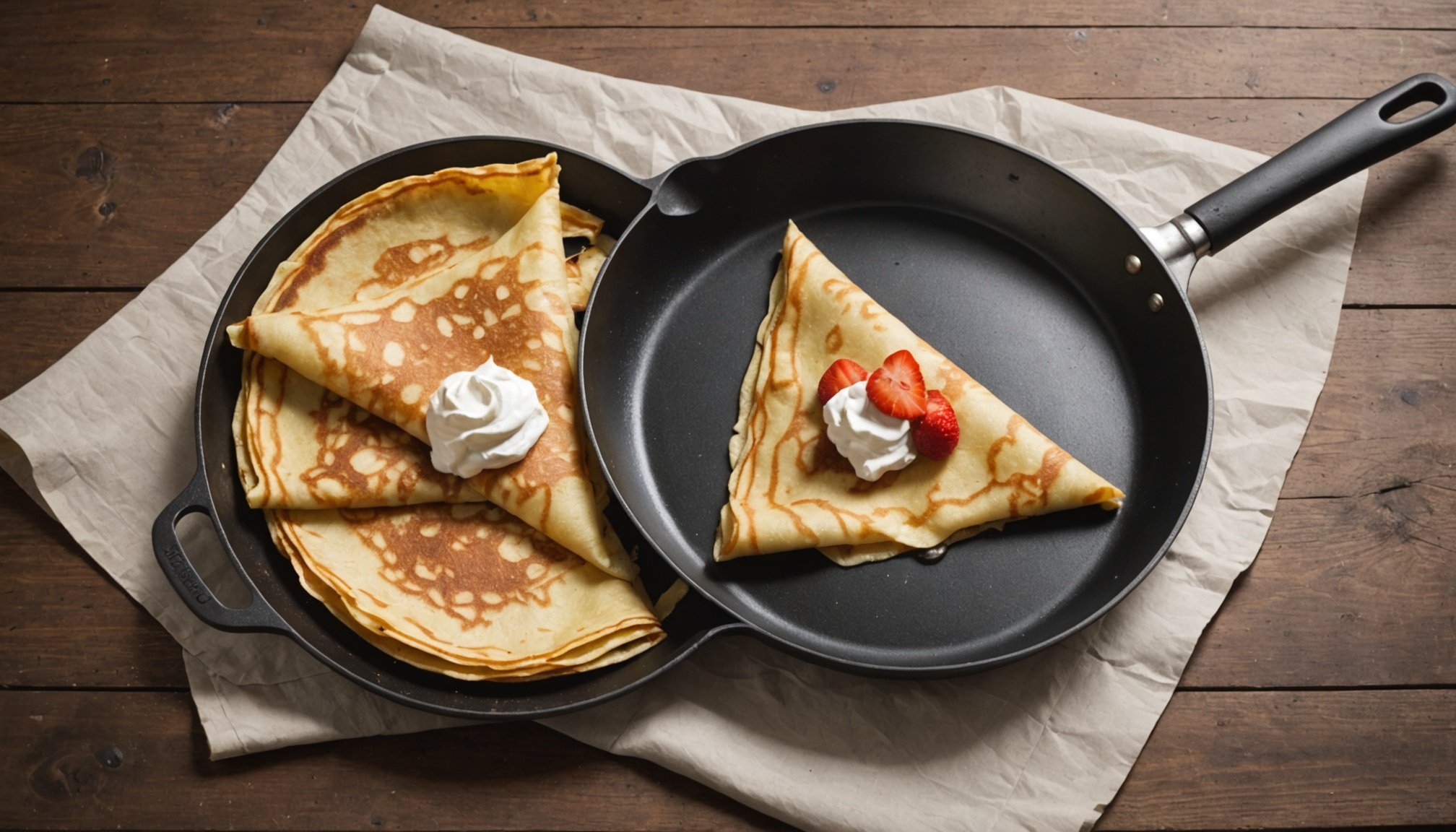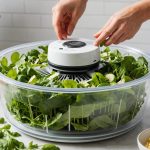In the delightful world of kitchen cookware, the selection and use of the right pan can elevate the cooking experience and the end result. Let’s take one of the most cherished breakfast marvels- the crepe. It is thin, light and can be tricky to craft. The secret to making the perfect crepes lies not only in the batter but also in the pan you use. You may wonder, what exactly is the ideal shape of a frying pan for flipping crepes?
In this comprehensive guide, we’ll explore the factors that come into play when deciding on the pan shape for your crepes, dive into the different types of pans available, and discuss the best way to use these pans.
Topic to read : How to Select the Correct Wattage in an Electric Steamer for Vegetables?
The Science Behind Pan Shape and Crepe Making
Before jumping onto the bandwagon of crepe making, it is crucial to understand the science behind the perfect pan shape. The ideal crepe pan is usually flat-bottomed with shallow, slightly sloping sides. This configuration facilitates easy flipping and even cooking of the crepe.
But why is the shape so important in the first place? The flat bottom ensures uniform heat distribution, essential for a perfectly cooked, golden brown crepe. The shallow, sloping sides allow for the batter to spread evenly and make the flipping process a breeze.
Also read : How to Determine the Best Height for a Kitchen Island That Serves as a Dining Table?
The Selection of Materials: Cast Iron, Steel, or Non-Stick
The choice of pan material directly affects the heat conductivity and life span of the pan, playing a significant role in the success of your crepe making endeavors.
Cast iron pans are traditionally used for making crepes. They offer excellent heat retention and even distribution, making them ideal for cooking delicate crepes. However, they are heavy and require a thorough seasoning process before use.
Steel pans, on the other hand, are lighter and heat up faster than cast iron, providing quick and even heat distribution. They are also more durable and resistant to scratching, making them a good choice for frequent crepe makers.
Non-stick pans are popular due to their convenience and ease of use. They require less oil, making them a healthier option and the crepes are easy to flip due to the non-stick surface. However, the coating can deteriorate over time, requiring more frequent replacement.
The Importance of a Good Handle
The handle of your crepe pan is just as important as the pan itself. It should provide a strong, secure grip and remain cool to the touch, even when the pan is hot.
A good handle will make flipping crepes a breeze and prevent accidents caused by slipping or dropping the pan. Look for a handle that is ergonomically designed for comfort, preferably made of heat-resistant material like wood or silicone.
The Art of Preparing and Cooking Crepes
Once you have selected the perfect pan, it’s time to turn your attention to the batter and the actual cooking process.
The perfect crepe batter should be thin and runny. This allows it to spread evenly over the flat base of your pan, creating a delicate, light crepe. Start by preheating your pan over medium heat. Then, pour a small amount of batter and quickly swirl it around to cover the base of the pan.
The key to cooking perfect crepes is to cook them over medium heat. This allows the batter to cook evenly without burning. Once the edges start to curl and the bottom is lightly golden, it’s time to flip. If you’ve chosen the right pan with a good handle, the flipping process should be straightforward and fuss-free.
Final Thoughts on Choosing the Ideal Frying Pan for Crepes
In conclusion, there’s no ‘one-size-fits-all’ answer when it comes to the ideal frying pan for crepes. The selection will largely depend on your personal preferences, cooking style, and the level of convenience you seek. Nevertheless, by considering the shape, material, handle, and using the right cooking techniques, you’re sure to perfect the art of crepe making. Whether you’re whipping up a decadent Nutella-filled dessert or a wholesome spinach and feta savoury option, your crepes will be flawless every time with the right pan.
In the grand scheme of culinary arts, the success of your dishes relies heavily on the tools you use. So invest in the right pan and enjoy the process of crafting delightful crepes in your kitchen.
Exploring the Leading Brands and Models of Crepe Pans
When you’re on a quest to find the perfect crepe pan, it’s essential to consider the leading brands known for their excellent performance and high-quality manufacture. Two of the most popular brands are Kuhn Rikon and Carbon Steel Cookware.
Kuhn Rikon is a Swiss brand popular for its impeccable craftsmanship and design. They offer a range of crepe pans with a non-stick surface and a stay-cool handle, ensuring a safe, comfortable grip for easy flipping. The pans also feature a heavy-duty base for optimal heat distribution, creating a golden brown crepe evenly cooked to perfection.
On the other hand, Carbon Steel Cookware is well known for its durable and lightly weighted steel pans. These are a great choice for those who prefer a quicker heat-up time and resistance to scratches. With a flat base and slightly sloping sides, these pans are ideal for making crepes.
When selecting a model, consider the pan size. A pan with a diameter of 10 to 12 inches is ideal as it offers ample space for the crepe batter to spread, resulting in a thin, evenly cooked crepe.
Maintenance and Care of Your Crepe Pan
Investing in a high-quality crepe pan is just the first step towards perfect crepes. Maintaining the pan’s excellent condition is equally important to ensure that it continues to deliver outstanding performance.
For cast iron and carbon steel pans, it’s vital to season them before the first use and periodically thereafter to maintain a non-stick surface. After each use, clean these pans with a soft sponge and mild soap, dry them thoroughly to prevent rust, and lightly oil to keep the seasoning intact.
In contrast, non-stick pans require less maintenance. They can be cleaned with a soft cloth or sponge and mild soap. Avoid using metal utensils or abrasive cleaners that can damage the non-stick coating.
Regardless of the type of pan, avoid drastic temperature changes to prevent warping or cracking. Allow the pan to cool down naturally before cleaning.
Conclusion: Mastering the Craft of Crepe Making
Mastering the art of crepe making is a journey, and the pan you choose can significantly influence the result. It’s a delicate balance of picking the right materials, understanding the science behind the ideal shape, and practicing the art of preparing and cooking crepes.
The perfect crepe pan should have a flat bottom for even heat distribution, slightly sloping sides for easy flipping, and a stay-cool handle for safety. Whether it’s cast iron, stainless steel, or a non-stick pan, the choice is subjective, based on your cooking preferences and convenience.
Renowned brands like Kuhn Rikon and Carbon Steel Cookware offer some of the best crepe pans in the market, known for their superior craftsmanship. However, maintaining the pan’s optimum condition is equally crucial for consistently delicious, golden brown crepes.
In the final analysis, the ideal crepe pan is an amalgamation of the right shape, heat conductivity, comfort, and durability. As you embark on this culinary journey, remember that the right tools are fundamental to success. Whether you’re a seasoned cook or a beginner, investing in a quality crepe pan is a step towards crafting delightful crepes, elevating your cooking experience.











